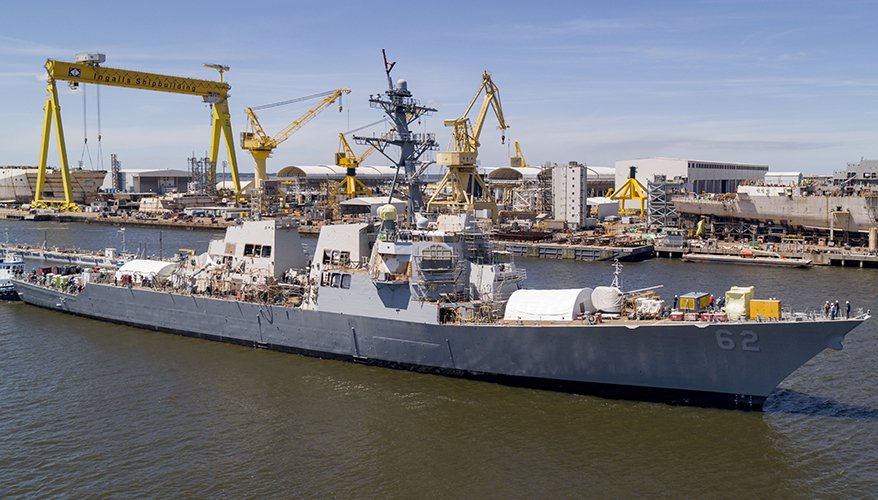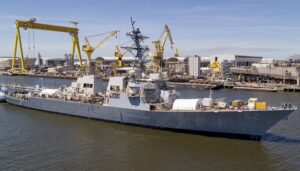Photo: U.S. Navy
“I’m not hating on DDGs (Destroyer, Guided Missile) – my only point was that last year Congress added a third and the reason we didn’t budget for three is, again, we don’t see the yards being able to produce three a year. We don’t see them being able to produce two a year. And that’s just data. It’s not what we wish to be true. But everybody’s struggling with skilled labor. Everybody’s struggling with supply chain. So it’s not getting better very fast from the data that I’ve seen – whether with submarines or DDGs. So two a year seems to be a reasonable place…”[1]—Under Secretary of Defense Mike McCord
By Kevin Policarpo
Under Secretary of Defense Mike McCord, the Pentagon’s top budget officer says U.S. shipyards do not have the capability to produce even two destroyers per year, placing them at a competitive disadvantage with China.
At the same time, China has surpassed the U.S. Navy in ship numbers.
Speaking to the U.S. Naval Institute, McCord said:
“I’m not hating on DDGs (Destroyer, Guided Missile) – my only point was that last year Congress added a third and the reason we didn’t budget for three is, again, we don’t see the yards being able to produce three a year. We don’t see them being able to produce two a year. And that’s just data. It’s not what we wish to be true. But everybody’s struggling with skilled labor. Everybody’s struggling with supply chain. So it’s not getting better very fast from the data that I’ve seen – whether with submarines or DDGs. So two a year seems to be a reasonable place…”[2]
Destroyer Shortage
McCord stated that the shipbuilding industry is currently building 1.5 destroyers per year.
The U.S. Navy has fallen on challenging times. U.S. shipyards are not sufficiently supported with the result that new ships are constructed with design flaws, unreliable technology, and some U.S. naval vessels are being cannibalized to keep others afloat.
McCord also argued that additional funding to making an extra destroyer per year isn’t a wise use of resources to push shipbuilders to deliver sooner:
“It’s just sort of piling up in the orders book and we’re still going to have the same problems of the yards producing faster until we get through the supply chain and the workforce issues … It is not to say that we would not be interest[ed] in a more robust production world where in having three DDGs or moving to three submarines, but it doesn’t seem to be … realistic.”
McCord argued that providing more funding is not the solution:
““If you keep sort of placing orders for things faster than they can be delivered, it’s good for the books, the balance sheets of the companies. But are you really, as the buyer, are you in the best place you’d like to be with any leverage or are you actually short of leverage when, you produce on time or you don’t produce on time. It doesn’t matter to me – I’m going to keep writing you checks,” [3]
Kimberly Aguillard, a spokeswoman for Huntington Ingalls Industries Shipbuilding, that constructs Arleigh Burke-class destroyers, told USNI News:
“Our shipbuilders will position to support whatever destroyer cadence the Navy needs and we have started by building, testing and taking the first Flight III ship to sea, which will be delivered later this year. We are a committed partner to not only our customers but to our network of nearly 1,200 suppliers as well. Together, we can build three DDGs a year if that is what the Navy and our country need…”[4]
David Hench, a spokesperson for General Dynamics Bath Iron Works,in Maine told USNI:
“We support the call for a consistent demand signal that gives shipyards and suppliers the predictability to make major investments in workforce and facilities, both to expand destroyer production and to ensure that capability remains intact well into the future … Those capital investments are currently underway in Bath, and we are confident there will be significant schedule improvement so we can meet the Navy’s expectations by the time construction begins on the anticipated multi-year contract.”[5]
Lawmakers are pushing the Navy to purchase three destroyers per year “… and added a third destroyer on top of the Navy’s request for two in FY 2023.”[6]
Despite the pressure from Congress, the Navy is sticking to buying two destroyers a year because as McCord explained: “We would love to live in a world where the yards could make three a year, or three submarines a year, but we don’t live in that world…”[7]
Shortfalls of the U.S. Naval Shipbuilding Industry
Following the end of the Cold War, the U.S. government began downsizing the defense industry. To stay relevant, the industry adapted and consolidated. Since 1993, in terms of shipyards, the number of public shipyards used by the Navy went from 8 to 4.[8] However, these shipyards have “…limited functional dry docks, old equipment, and regularly delay maintenance for the submarine and aircraft carrier fleets.”[9]
Since the 1960s, three shipbuilders had left the industry and only one shipyard has opened. General Dynamics and Huntington Ingalls Industries (HII), the two largest shipbuilders in the U.S., “…reported a record new construction backlog for 2020 competing for drydock space with essential ship maintenance.”[10]
Additional attention also has to be given to private shipyards, which construct and maintain most of the current fleet, from fleet oilers to destroyers. According to National Defense, the main challenges for private shipbuilders are personnel shortages, increasing costs of materials, and inconsistent acquisition priorities.
In terms of skilled technicians, the U.S. is suffering a decrease of experience. Since the 1990s, the skilled members of the workforce are getting older, leaving the shipyards with workers that lack the necessary experience. The lack of skilled technicians have caused “… delays in construction and maintenance, compromising the Navy in a possible future engagement.”[11]
Rising costs of materials is another problem for shipbuilders. The Congressional Budget Office (CBO) found that the shipbuilding cost index for the Navy was 1.2% higher than overall economic inflation between 1986 and 2009.[12]
The increased cost is due to specialized construction demands, decreased competition between shipyards (which would help drive down prices), and low-volume orders.
An example is cited in a Bloomberg article published on February 20th, 2023, which noted the failure of the Littoral Combat Ship (LCS). The Pentagon’s strict requirements and the small number of available contractors contributed to many defense projects going over budget, including the LCS. Originally, the Navy requested a fleet of 55 LCSs, with each ship costing $220 million. Due to cost overruns, the fleet shrank to 35 ships with each ship costing $478 million apiece.[13]
Critics say another factor is the Navy’s inconsistent acquisition process and shipbuilding plan. Since the end of the Cold War, the Navy has been wavering between projects, halting efforts to modernize and adapting to changes in naval warfare. The program shutdowns harmed shipyards as each project “… requires significant investment to properly construct and maintain new ships, only for it to be squandered when the Navy cancels orders and moves to develop other systems.”[14]
This also encourages further consolidation of contractors, which limits the competition that facilitates a robust naval acquisition strategy.
GCaptain Report
In a GCaptain article published on February 26th, 2023, Captain John Konrad criticized U.S. shipyards. He argued that large ships built in the United States cost several times more than a similar ship built in Asia. He cited government funded ships going over budget and experiencing costly delays.
In addition, The New York Times published a report that accused shipbuilding lobbyists of working against the Navy by keeping decommissioned vessels in operation so as to maintain profits.[15]
Eric Lipton, writer of the NY Times article “The Pentagon Saw a Warship Boondoggle. Congress Saw Jobs…” noted that the LCS ships were to be decommissioned after 4 years due to repeated engine failures and technical issues.[16]
The Zumwalt-class destroyers and the LCS, which were meant to be cutting-edge systems to provide the Navy increased capability, turned into expensive failures.
Konrad argues that U.S. shipyards “… are failing and have little to show for the eye-watering prices they charge their only customer.”
Konrad suggests a new approach:
“Some have suggested that the US Navy directly subsidize shipyards and help build infrastructure but the US Navy is the customer, and would not be in a legal or ethical position to provide cash outside of contracts. That is the job of the US Maritime Administration (MARAD) but unfortunately, the US Navy has mostly ignored that organization for years, has given it little support in Congress and has watched as it has withered away to less than 1,000 employees.”[17]
Konrad says the U.S. Navy “… has also failed to build enough simple vessels like fireboats and salvage tugs or enough oilers to replace critical fuel storage tanks that leaked in Hawaii causing irrefutable harm.”[18]
Conclusion
The U.S. Navy’s struggles to modernize and adapt to the changing times. At the same time, China’s development of its commercial shipbuilding sector has allowed it to also produce aircraft carriers and other war ships so that in numbers, China’s People’s Liberation Navy deploys more vessels than the U.S. Navy. U.S. shipyards’ problems are evident in aircraft carriers and littoral combat ships that don’t work or need refitting or need to be cannibalized to keep other ships afloat. There are methods to solve the current situation, methods that will require leadership to make the tough decisions that will bring long-term change. The U.S. shipbuilding industry must seize the chance in order restore the Navy to its position as a naval superpower.
Footnotes
[1] Mallory Shellbourne, OSD Comptroller Says U.S. Shipyards Can’t Build 3 Destroyers a Year, Published March 21, 2023, news.usni.org, https://news.usni.org/2023/03/21/osd-comptroller-says-u-s-shipyards-cant-build-3-destroyers-a-year
[2] Mallory Shellbourne, OSD Comptroller Says U.S. Shipyards Can’t Build 3 Destroyers a Year, Published March 21, 2023, news.usni.org, https://news.usni.org/2023/03/21/osd-comptroller-says-u-s-shipyards-cant-build-3-destroyers-a-year
[3] Ibid.
[4] Ibid.
[5] Ibid.
[6] Ibid.
[7] Ibid.
[8] Heberto Limas-Villers, Improving the Shipbuilding Industrial Base, Published January 21, 2022, nationaldefensemagazine.org,https://www.nationaldefensemagazine.org/articles/2022/1/21/improving-the-shipbuilding-industrial-base
[9] Ibid.
[10]Ibid.
[11] Ibid.
[12] Ibid.
[13] Peter Marin, Courtney McBride and Roxana Tiron, Russia’s War on Ukraine, China’s Rise Expose US Military Failings, Published February 20, 2023, bloomburg.com, https://www.bloomberg.com/news/features/2023-02-21/pentagon-dod-actions-spark-concern-if-us-military-equipped-for-war
[14] https://www.nationaldefensemagazine.org/articles/2022/1/21/improving-the-shipbuilding-industrial-base
[15] https://www.nytimes.com/2023/02/04/us/politics/littoral-combat-ships-lobbying.html
[16] https://www.nytimes.com/2023/02/04/us/politics/littoral-combat-ships-lobbying.html
[17] https://gcaptain.com/oped-us-navy-shipbuilding-badger-problem/
[18] Ibid.


